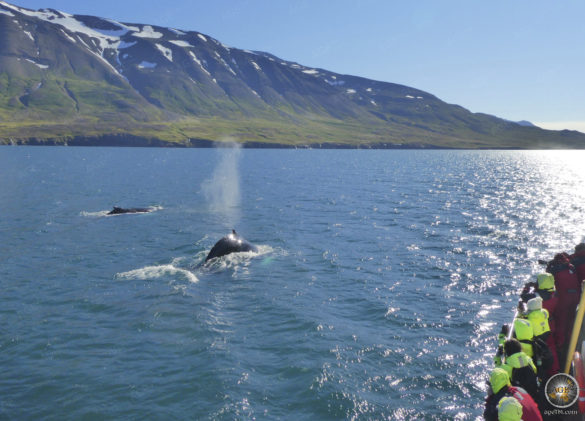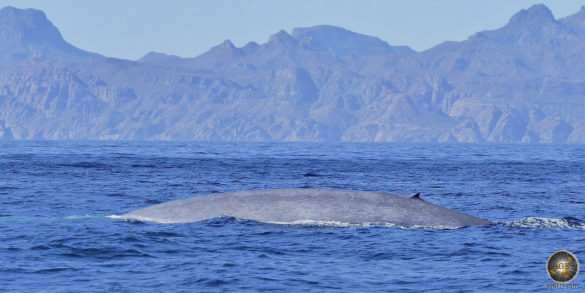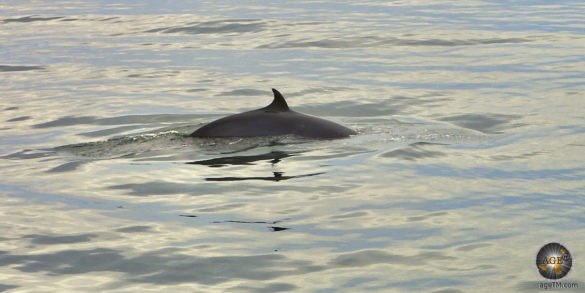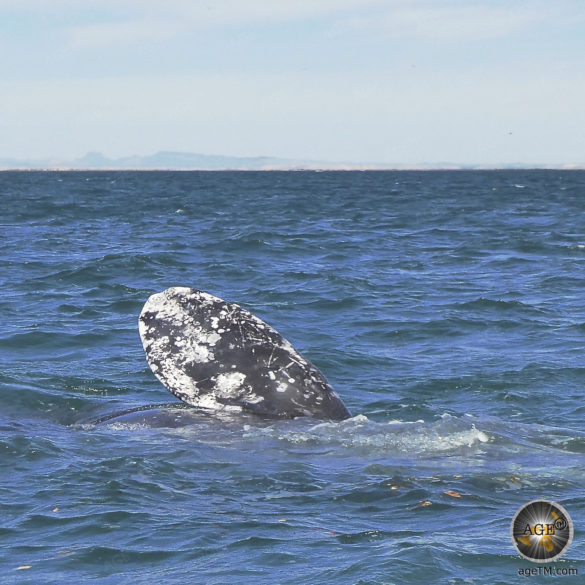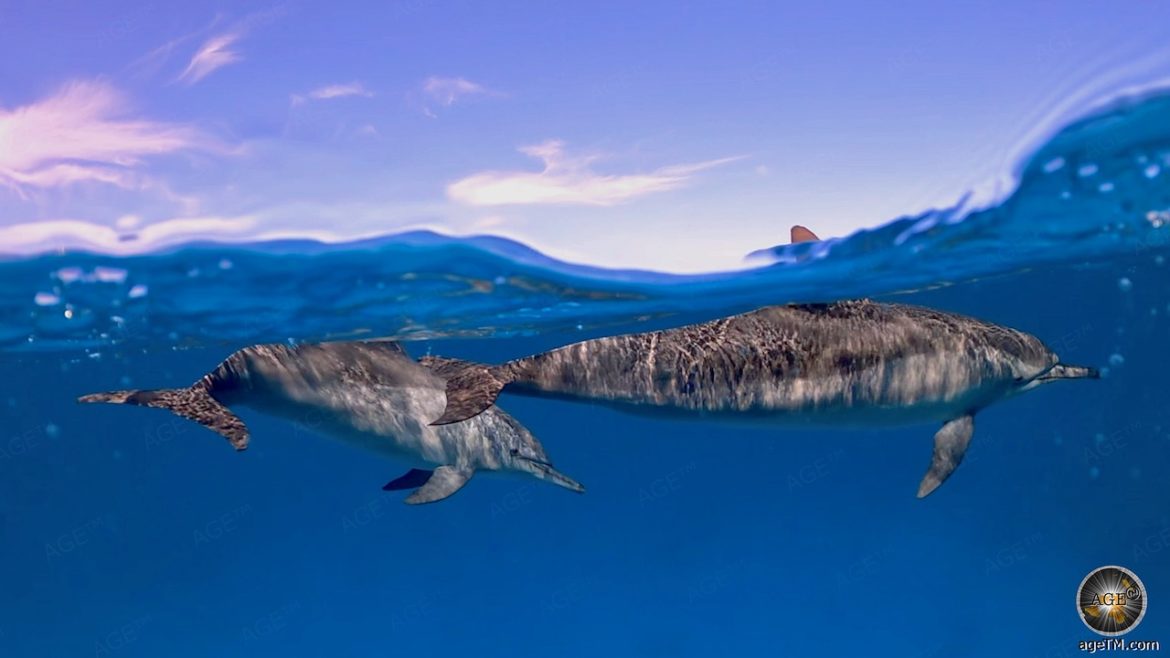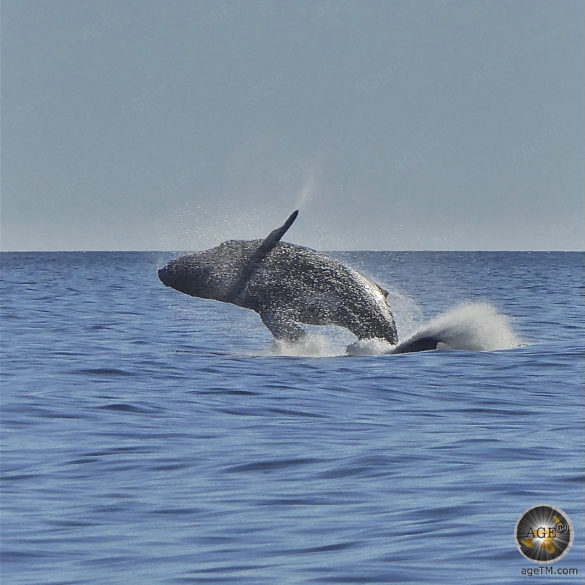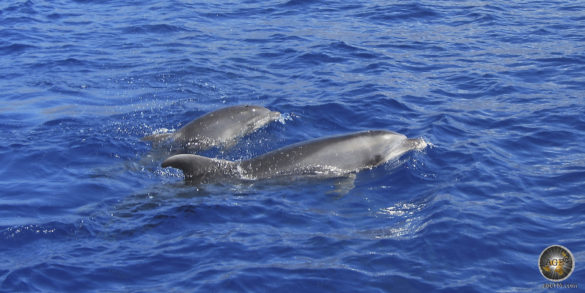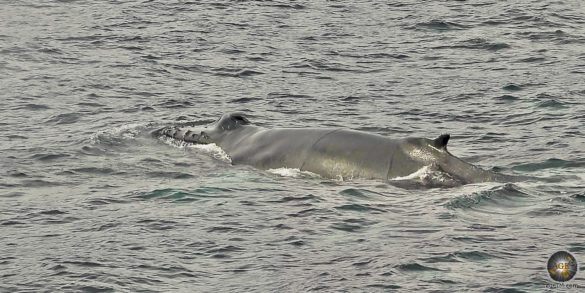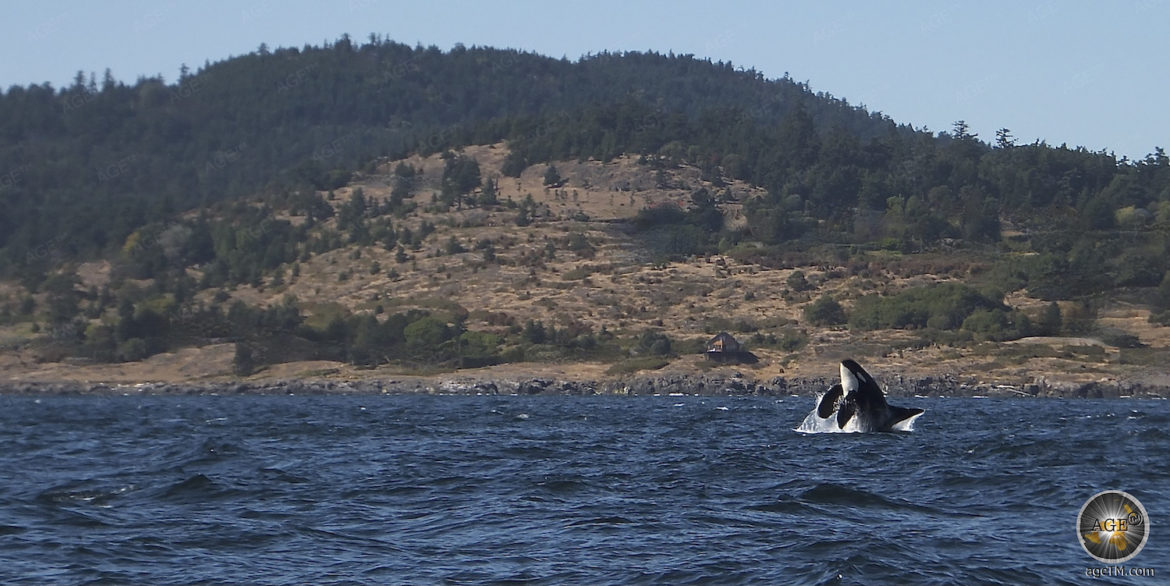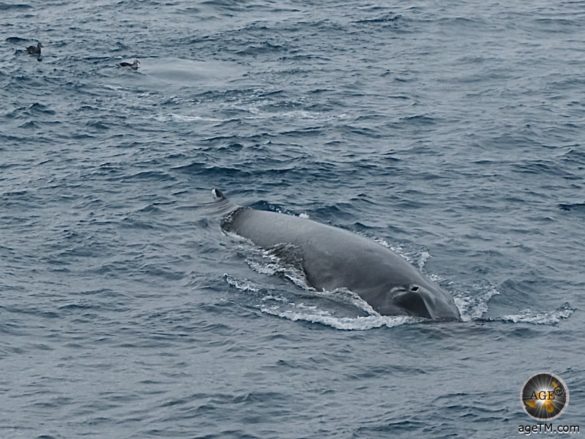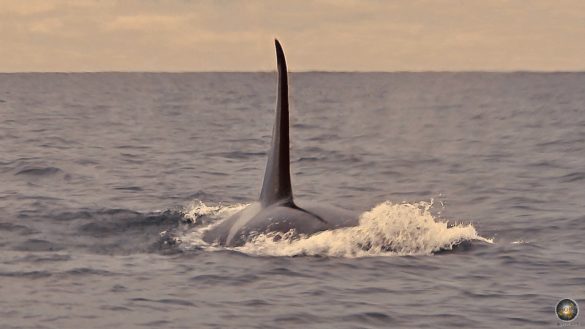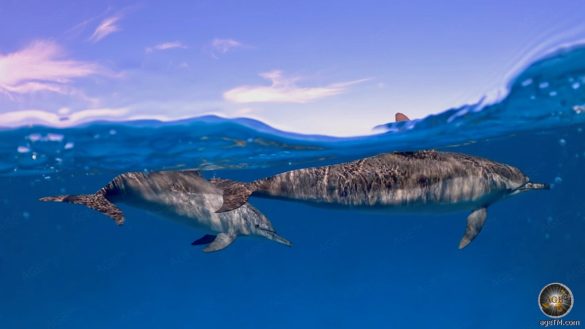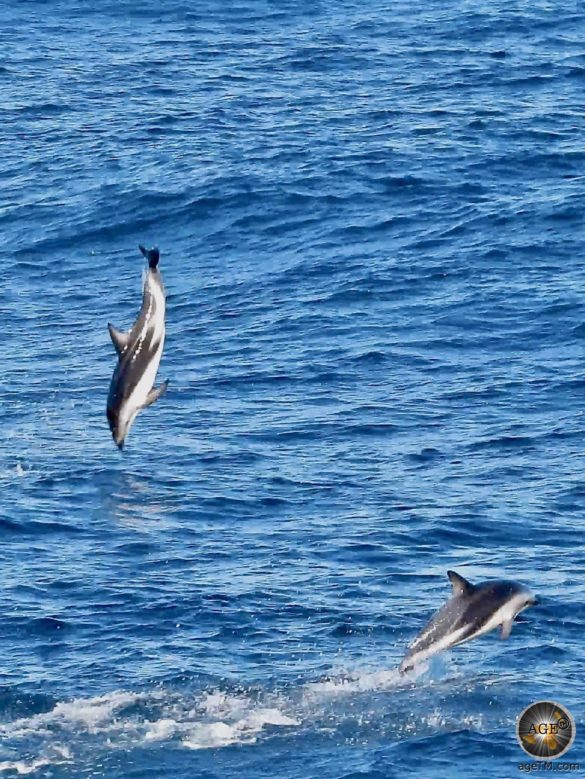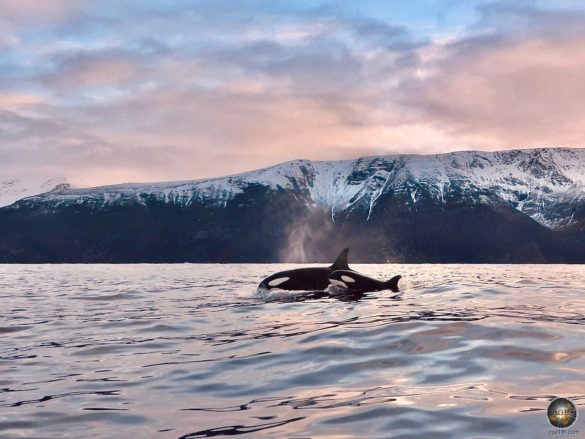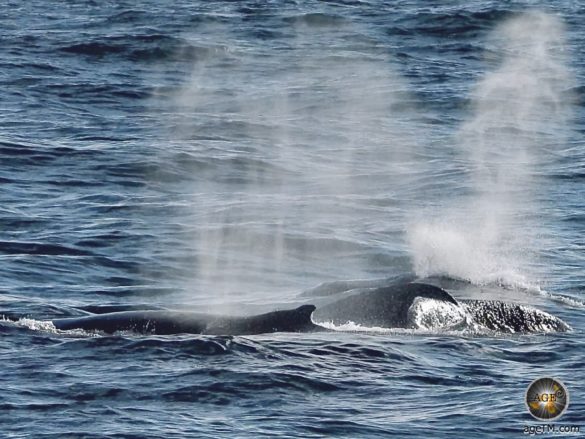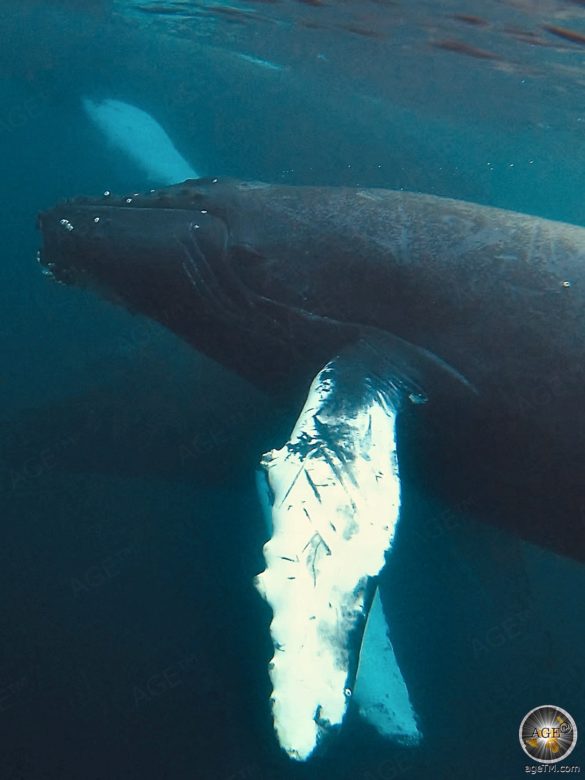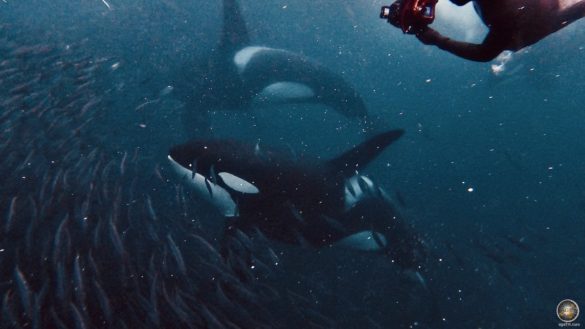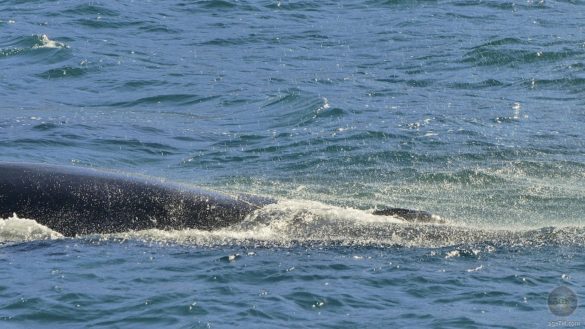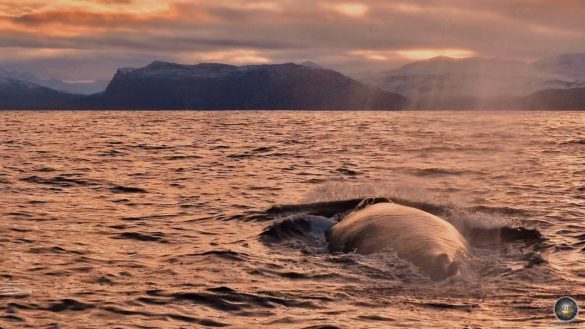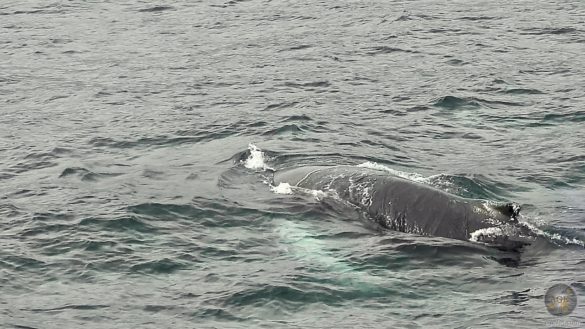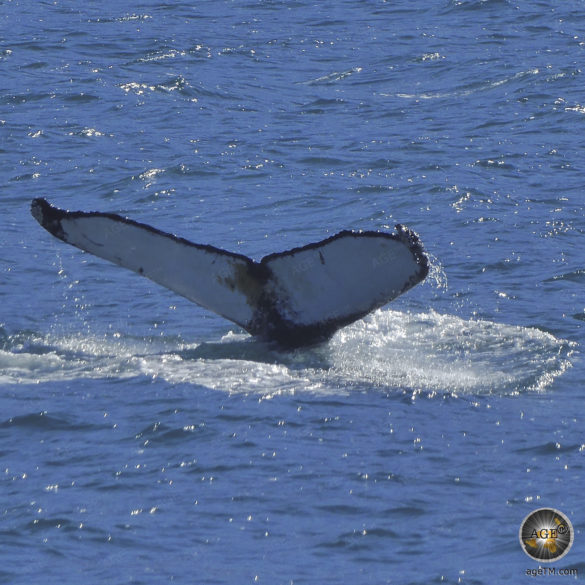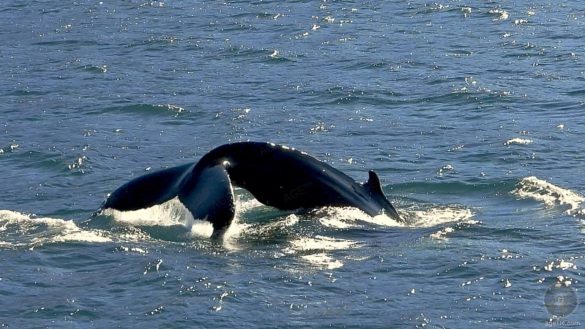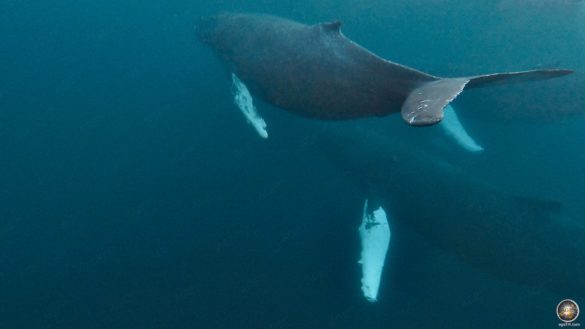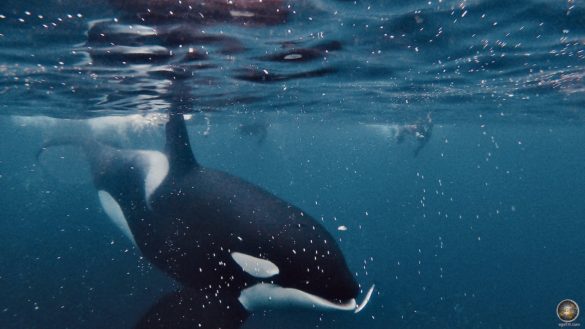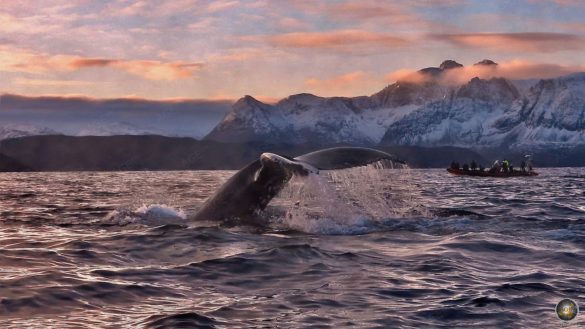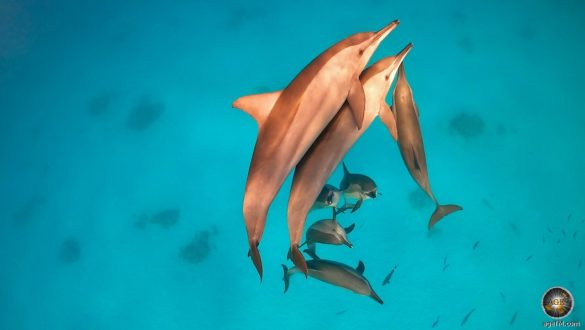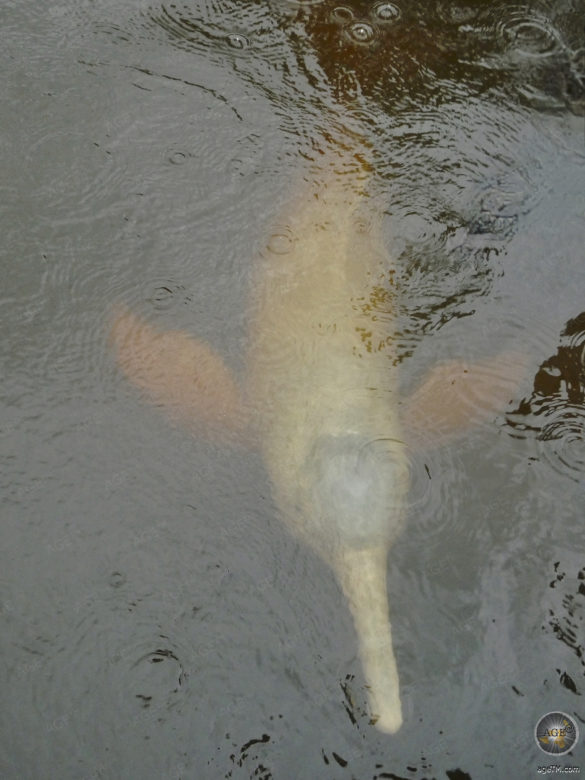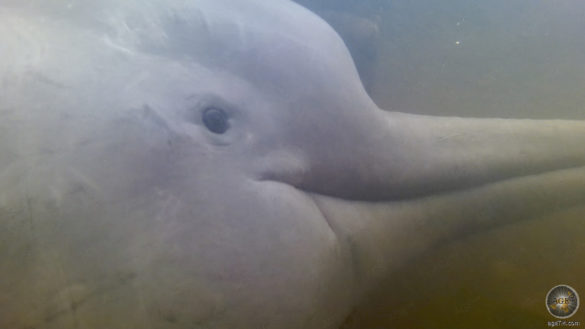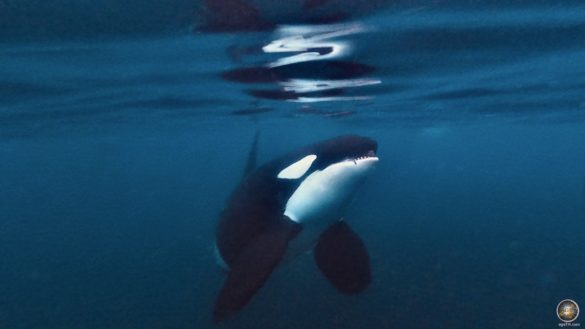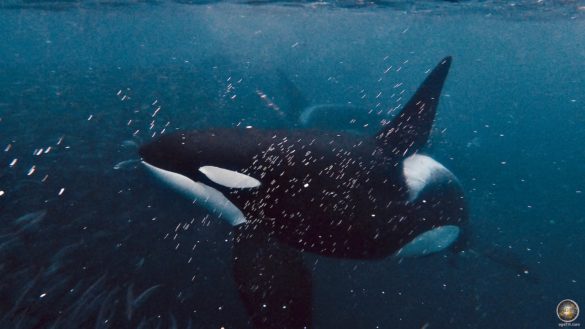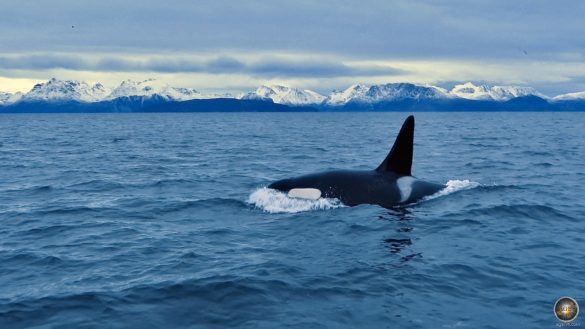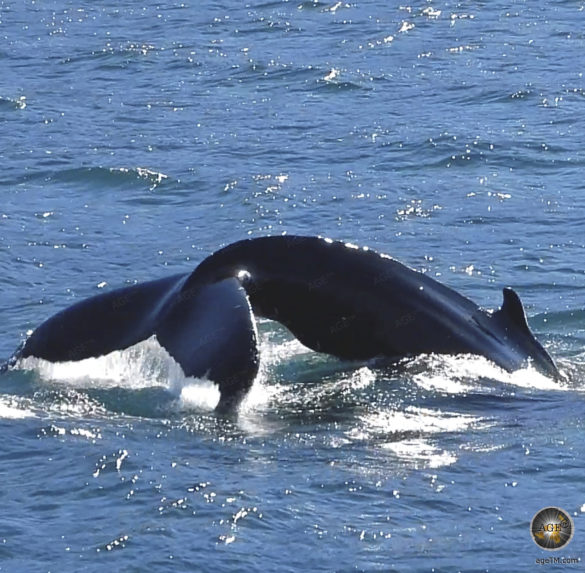We stare intently at the surface of the water. A gathering of excited seabirds has revealed the secret: Here's a whale. The minutes pass ... the ship stays where it is and our guide reminds us to be patient ... we eagerly search the surface of the water. In the distance, a blow divides the waves and a tail fin sits enthroned on the spray for a brief moment before disappearing ... Silence. Suddenly a loud snort pulls us out of the tension. Water hisses and the massive body emerges from the water right next to the boat. A breathtaking moment.
We stare intently at the surface of the water. A gathering of excited seabirds has revealed the secret: Here's a whale. The minutes pass ... the ship stays where it is and our guide reminds us to be patient ... we eagerly search the surface of the water. In the distance, a blow divides the waves and a tail fin sits enthroned on the spray for a brief moment before disappearing ... Silence. Suddenly a loud snort pulls us out of the tension. Water hisses and the massive body emerges from the water right next to the boat. A breathtaking moment.
Whale watching with respect
Are you one of the lucky ones who has already seen these fascinating marine mammals? Or are you still dreaming of your first personal encounter with a whale? Whale watching is a dream for many people. Others are strictly against it. Is whale watching ok? AGE™ believes that whale watching is whale conservation. Provided the observers show respect and do not harass the animals. Especially in a country like Iceland, where whaling is still legally permitted, it is important to promote sustainable eco-tourism and thus the protection of whales. The opportunity to earn money with whale watching is and was in some countries a banal but important reason to change from a whaler to a whale protector. With a change of course, the perspective changes and ultimately the attitude. A good path for humans and whales. The next step is to ensure that whale tours do not disturb the natural behavior of the whales. We are jointly responsible for this.
In the spirit of the whales, you should always pay attention to nature-conscious providers. Distance rules are mandatory so that the animals are not stressed and there is no risk of injury. A whale tour must not end in a drive hunt. The larger the boat, the greater the distance to the whales should be. In addition, a clear restriction on the number of boats is to be welcomed. As long as whale watching is done with due respect, it promotes an understanding of these wonderful creatures. During the tour, something is often told about the biology of the whales and the urgent need to protect the oceans is pointed out. Whale observations are used for enlightenment. True to the motto: People only protect what they know and love. Anyone who has good photos of humpback whale fins can even help science. With a little research in advance and appropriate behavior on board, you can enjoy your personal encounter with the gentle giants without a guilty conscience.
animals • mammals • whales • Wildlife Viewing • Whale Watching • On the trail of the gentle giants
Breathless moments & deep encounters
Whale watching is childish enthusiasm, growing excitement and an unfathomable exhilaration. Every fin and every back is exuberantly celebrated with Ah and Oh calls.
Is it the size of the whales that fascinates us so much? Huge creatures that make us feel like we're not as important as we think we are? Is it the gentleness of the whales that makes them so fascinating? The weightless elegance of their massive bodies? Or are they the mysteries of the deep seas that suddenly become a little bit tangible for us? A glimpse into a strange, wonderful world? An encounter with whales is unique and makes a very special chord vibrate in us.
Every whale sighting is a gift. Of course there are still very special favorite moments: The sharp, loud snort of a humpback whale, which appears right next to the boat. A whole pod of fin whales in one go. Or just the wonderful contrast of dark distant tail fins dancing in front of a white snowy shore. The innocent, pure moment when an orca calf and its mother gracefully glide by. Dive in and out in a steady, even rhythm. Humpback whales darting out of the water, heaving their mighty bodies out of the waves and disappearing back into the sea with a loud splash.
You will never forget the day you first saw the huge back of a blue whale. His blowhole is so big that every truck tire looks small in comparison. The breathless moment when the giant of the seas actually lifts its huge tail fin in farewell. There are a lot of special moments when whale watching. And yet they remain pure luck.
Happiness is the incredible feeling of being showered by the blow of a whale as it passes right next to the small RIB boat. The wet, dripping lens of the camera, which suddenly becomes a minor matter. After all, who can claim to have felt the breath of a whale? Happiness is when fountains of water shoot up all around you. Far but numerous. Where should you turn? Whales - whispers an awestruck echo in your head. All over. And sometimes luck is just a matter of luck: A group of pilot whales on the high seas. A pod of dolphins accompanying the boat. Leaping whales in the distance, on a normal walk on the beach. Special experiences await everywhere.
Embark on the journey. Expect nothing and receive everything. With a bit of luck, you too will find very personal moments in which you feel deeply connected to these wonderful creatures of the sea.
animals • mammals • whales • Wildlife Viewing • Whale Watching • On the trail of the gentle giants
These locations promise great whale sightings
Whales migrate, so plan not only for the best locations, but also for the right times of year. There are some resident groups of whales, such as the short-finned pilot whales in Tenerife. These can be seen in the same area all year round. However, many whale species migrate back and forth between a summer range and a winter range. For food, they cavort in cool, nutrient-rich waters. Reproduction, on the other hand, usually takes place in warmer regions.
gray whales for example, wander between Mexico and Alaska back and forth. Their nursery is in the bays of Baja California and in Alaska eat your fill. humpback whales switch between polar areas where they feed and tropical areas where they breed. You walk along the east coast of Australia. Queensland is considered an insider tip for whale watching between July and October.
Whale fans also get their money's worth in Europe. Iceland, Norway and the Azores offer excellent whale watching opportunities. For the Azores April to October is considered a good time for whale watching. In to Iceland Humpback whales are common, especially between June and September Minke whales to see. In winter the chances of Orca sightings increase. Norway has from May to September sperm whales to offer and between November and January you can see humpback whales and Orcas observe. You can even snorkel with whales in Skjervoy.
Vancouver Island in Canada is another good address for orca tours. The coast at Kaikura in New Zealand and the waters around the Dominica Island are known for sperm whales. In the Amazon of Ecuador and Peru wait rare River dolphins to you of you. There are countless wonderful places that make whale watching possible.
And where do you find it blue whale? The king of the whales? You have a good chance of observing the largest animal in the world, for example in the Gulf of California at Mexico. Every year between January and March, blue whales come into the waters Loreto. Another insider tip are the Azores. Best Months to Spot Blue Whales Azores to see are April and May.
animals • mammals • whales • Wildlife Viewing • Whale Watching • On the trail of the gentle giants
What do you see while whale watching?
Each whale species has an individual physique and its own behavioral repertoire. The blow is the first to be seen and usually also heard. This is the fountain of water created when the whale exhales. Shortly thereafter, the back becomes visible. The dorsal fin is called the fin in technical jargon and the tail is called the fluke. Which body parts can be seen depends on the whale species and their behavior at that moment.
The orca, for example, is known for its high, sword-like dorsal fin. In the minke whale, on the other hand, the fin is small and sickle-shaped. Gray whales have no dorsal fin at all. This whale species often lifts its head out of the water. The humpback whale rarely shows its head, but regularly shows its fin when diving. With its fluke it gives momentum to deep dives. The blue whale, on the other hand, trumps with body size. His huge back is best visible, sometimes he also raises his tail. Fin whales, the second largest whales, dive at a more acute angle and have been known to turn on their side when feeding, sometimes showing their stomachs. Each whale species has its own special features. What you can see while whale watching depends mainly on the whale species that you are looking at.
animals • mammals • whales • Wildlife Viewing • Whale Watching • On the trail of the gentle giants
Snorkeling with whales
Another indescribable experience is seeing whales underwater. To see her in all her beauty and glory. In Norway, for example, you can snorkel with orcas and jump into the cool water with humpback whales. The ideal time for this is November to January. In Australia, you can share the water with minke whales in July and meet humpback whales between July and October. In Egypt you have the best chance to swim with spinner dolphins in the wild all year round.
Choose providers with experience, small boats and small groups. Never wear insect repellent or sunscreen when entering the water and keep quiet so as not to disturb the animals. The whales decide if you feel like it. Even a gentle flapping of the fins carries the sea giant into an unreachable distance. Be aware that a great sighting underwater is more difficult than an exceptional sighting above water. Plan enough time. Sharing the water with a whale is an incredible feeling that you will never forget.
animals • mammals • whales • Wildlife Viewing • Whale Watching • On the trail of the gentle giants
I want to see a whale jump!
This sentence can be heard on many whale tours by the discerning audience and is often disappointed. Some whale species never jump. Every whale is different and it is definitely a myth that a whale tour automatically sees jumping whales. If you still don't want to miss this unique spectacle, you should select whale species that are known for frequent jumps. For example the humpback whale or the orca. Nevertheless, a sighting of these species by far does not automatically mean an acrobatic performance. Why do whales jump? Many reasons have been discussed. Maybe you want to get rid of such annoying parasites? Or are they really just having fun? It is now assumed that the animals communicate with each other through their jumps. This could be the reason why they indulge in more jumping activity during the mating season, for example. If you want to see a whale jump, you have the best chance in the breeding areas of the humpback whales.
animals • mammals • whales • Wildlife Viewing • Whale Watching • On the trail of the gentle giants
Code of conduct for gentle whale tours
Many countries have now realized that protecting whales and having a good image are also good for business. For example, on the Canary Islands, the government awards the “Blue Boat” certificate to providers who comply with the guidelines for gentle whale watching. Providers without a license should be avoided. In the Laguna San Ignacio of Baja California in Mexico, the regulation applies that a maximum of two boats may observe the same group of whales at the same time. This is a sensible and commendable rule to protect the gray whale nursery. IceWhale has also created a "Code of Conduct" in Iceland. Members abide by this code of conduct to protect whales. Compare different tours and find out about the protection regulations in each country. Look for unique selling points that indicate a responsible provider: Some run a small museum themselves, are committed to environmentally friendly innovations such as electric boats or are among the pioneers who have campaigned against whaling and for environmentally friendly whale watching.
With heart and mind
Enjoy whale watching to the fullest, but don't pressure the operators. Encourage them to actively engage in whale conservation. When your tour operator cancels a whale watching tour, they do so for a reason. Perhaps he saw that the whale takes unusually short breaths on the surface? This is a sign of stress, and it's fair and sensible for the boat to turn around and find another animal that's more relaxed.
Curb your expectations and give the animals space. Whale watching is a natural spectacle and cannot be planned. Many whales are relaxed and not bothered by a boat sailing alongside them. Some even find boats exciting and swim closer on their own accord. Dolphins often enjoy surfing the bow wave or running races. Enjoy the gift of the moment. However, if whales clearly remain at a distance or turn away, then this should definitely be respected.
A ship should never endanger whales, cut off their path or actively divert them from their swimming course. Whales should never have to avoid a boat. If you notice violations, it makes sense to speak to the nature guide directly and, in case of doubt, to contact the responsible persons of the organization.
Choose whale tours carefully, then nothing stands in the way of a personal deep encounter with the fascinating sea giants. Seeing a whale is always a unique experience. And it's breathtaking every time. In the footsteps of the gentle giants with heart and mind.
An older version of this article was published in the print magazine "Living with Animals".
Whale Watching with AGE™
Whale watching in Iceland
• Whale Watching in Dalvik - Pioneers of Whale Protection in the Icelandic Fjord
• Whale Watching in Husavik - With wind power and electric motor
• Whale Watching in Reykjavik - Whales and Puffins
Whale watching on expedition trips
• Antarctic voyage with the expedition ship Sea Spirit
• Galapagos cruise with the motor sailer Samba
Exciting articles for whale fans:
Snorkeling with Whales & Dolphins
• Whale Watching in Skjervoy, Norway - Humpback Whales & Orcas up close
• With diving goggles as a guest at a herring hunt of the orcas
• Diving and Snorkeling in Egypt - Biodiversity in the Red Sea!
Information about whales & dolphins
• Amazon River Dolphin Wanted Poster
• Humpback Whale Wanted Poster
• Whales in Antarctica
animals • mammals • whales • Wildlife Viewing • Whale Watching • On the trail of the gentle giants
Personal whale watching experience in Egypt, Antarctica, Australia, Ecuador, Galapagos, Iceland, Canada, Mexico, Norway and Tenerife. Information on site or on board by marine biologists & nature guides or discussions with the management.
Whaletrips.org (oD): Homepage about whale watching in different countries [online] Retrieved on September 18.09.2021, XNUMX, from URL: https://whaletrips.org/de/


